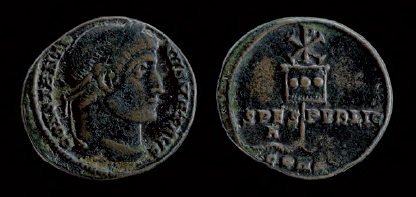
Constantine the universal bishop – The Donatist schism and the Council of Arles – The Arians and the Council of Nicaea – The Christian emperor after Nicaea – The Church after Constantine
When I was a boy, the ruler who had enjoyed a reign of terror in Rome was brought down by the leader of an army of Gauls, who attacked the gods to whom they had prayed just before. Having defeated the person who had allowed the cities to prosper, and thinking it to his own advantage to recognize some other as god, he, on the one hand, used the sacred treasures to build the city upon which his heart was set, but on the other made absolutely no alteration in the traditional forms of worship; though poverty reigned in the temples, one could see all the rest of the rituals being fulfilled.
This was the recollection of the aged Libanius, delivered in a speech in around AD 390. The pagan orator was no fan of Constantine, but he wished to remind the reigning emperor Theodosius that his predecessor, the first Christian emperor, had insisted on toleration of all faiths, even if he had not spent lavishly on the temples as he did in his later years on churches. Theodosius was unmoved. He declared Christianity the religion of state and shut down temples across the empire.
Constantine’s interest was not to effect the triumph of Christianity throughout his lands, but rather to appease the god who had granted him victory. He would give that deity no cause to withdraw favour, and so allowed worship to continue in all its forms. The pagan cults caused him little concern in that regard, and he merely curtailed those excesses that he personally considered particularly foul, for example ritualized prostitution and homosexuality in some temples dedicated to Aphrodite (Venus). However, the Christian Church was another matter, for it was riven with deep cracks. From shortly after the Battle of the Milvian Bridge Constantine was adamant that unity should be established among the Christians. But his desire could not be effected on the battlefield, and his interlocutors were not his lieutenants who owed him absolute obedience. They were bishops, and to corral them Constantine required a range of skills he only weakly possessed: patience not action, persuasion not force, compromise not diktat. He would attempt to deal with the bishops as a bishop, a ‘first among equals’, mixing flattery with firmness. However, the general was never far from the scene.
Constantine the universal bishop
As Claudia Rapp has recently shown, the authority of the fourth-century bishop was tripartite: spiritual, ascetic and pragmatic. But this was not a stool resting equally upon all three legs. Spiritual authority was the foundation of all, a divine gift that existed independent of its recognition by others. Those to be endowed with spiritual authority prepared themselves through pious practice, acts of discipline and asceticism, the latter most obviously derived from the broader Greek term for this type of behaviour, askesis. Those endowed with spiritual authority need not stand for decades atop pillars or confine themselves to the desert, but some did, and such ascetic behaviour was recognized by others as holy. It conferred ascetic authority, which might further be translated into pragmatic authority, when leadership roles were assigned to men who had demonstrated their piety, often through long years. Pragmatic authority, as wielded by bishops, was dependent upon spiritual authority; it was earthly recognition that one possessed a divine gift, and that this had been demonstrated through ascetic practice. Constantine knew that he too enjoyed spiritual authority, a divine gift, and that his acts of war were his askesis, from which his pragmatic authority derived. He also knew that in all categories his authority surpassed that of any single bishop, or indeed of them all combined. If bishops were successors to the apostles, and by virtue of their ordination received the same Holy Spirit as had the apostles from Christ, Constantine came to consider himself a second Christ.
Progression from spiritual awakening through ascetic practice to pragmatic authority can be identified in the lives of many devout bishops – for such lives, increasingly, were written by their disciples in emulation of the Evangelists – and the most renowned of the fourth century devoted themselves in turn to education, contemplation and ministry. Their lives, recorded in three stages, replicated that of Moses, who was recognized as the prototypical episcopal leader. Moses was also, as we have seen, the model that Eusebius of Caesarea, a bishop, chose for the emperor in his Life of Constantine. And in the same work, Eusebius reported that:
On one occasion, when entertaining the bishops to dinner, [Constantine] let slip the remark … ‘You are bishops of those within the Church, but I am perhaps a bishop appointed by God over those outside.’ In accordance with this saying, he exercised a bishop’s supervision over all his subjects, and pressed them all, as far as lay in his power, to lead the godly life.
Scholars have forced this saying to do some rather heavy lifting, attaching to it the notion that the later Roman and Byzantine state conceived of no distinction between church and state authority, and established an ideology of rulership known as ‘caesaropapism’. We need not become enmeshed in that discussion, for it is perfectly clear that Constantine was simply flattering his guests, suggesting a comparison with his majesty. Moreover, what he said was literally true: Constantine retained the title pontifex maximus, in which capacity he was chief priest presiding over the leaders of all recognized Roman cults, including now the cult of the Christian god, although he was not a devotee of all cults. Since he was not yet baptized, Constantine still stood outside the Christian Church. The emperor was, in a very real sense, a ‘bishop … over those outside’ and a ‘universal bishop’, a style accorded to him in Greek (koinos episkopos).
Constantine considered the bishops another group of subordinates, whose spiritual and pragmatic authority was not qualitatively different to his own, just less abundant. As a general, not a bishop, Constantine understood that loyalty to the commander-in-chief was achieved not through consultation but through the chain of command. His generals and their subordinate officers, so long as they were loyal, guaranteed the efficacy of the fighting force and its devotion to the emperor and his goals. So it would be with the Christian Church and its generals, the bishops, who were his imperial subjects. Thus, ‘like a universal bishop appointed by God he convoked councils of the ministers of God’ (VC I.44), the first being at Arles in 314.
The Donatist schism and the Council of Arles
In the aftermath of the Battle of the Milvian Bridge Constantine was confronted for the first time with the problems of internecine strife within the Christian Church. When he secured control of Maxentius’ dominions in 312, Constantine distributed donatives to the various religious communities in Italy and North Africa now under his jurisdiction, notably in Rome and Carthage. When the severed head of Maxentius was sent across the Mediterranean to confirm Constantine’s victory, a substantial cash sum went with it, to be distributed among his most favoured subjects. Eusebius purports to record the letter sent to the bishop of Carthage, one Caecilian, explaining how he will receive a cut (HE X.6):
Inasmuch as I have resolved that in all provinces, namely Africa, Numidia and Mauretania, certain named ministers of the holy Catholic religion should receive some contribution towards expenses, I have sent a letter to Ursus, the eminent finance officer of Africa, informing him that he must arrange a transfer to your steadfastness of 3000 folles in cash. Your task upon receipt of this sum is to see that it is distributed among all the persons named above according to the schedule supplied to you by Ossius [of Cordoba].
The distribution list has not been preserved, but one can be certain that those whom Ossius favoured with the emperor’s largesse did not include the Christian faction who demanded the removal of Caecilian and the recognition of their own candidate, Donatus, as bishop of Carthage. In spring 313, having left Rome, Constantine received a petition from these Christians seeking his intervention in their dispute.
The reason for the dispute lay in the unhappiest of circumstances: during the Great Persecution, certain North African priests had succumbed to the persecutors and handed over sacred vessels and scripture. These were called traditores, literally ‘handers-over’, from which of course we derive the term ‘traitors’. It was universally recognized that ‘traitors’ should no longer administer the sacraments, but the North African community was divided on whether this was to be enforced retrospectively. Since all ‘traitors’ had continued to administer the sacraments between their ‘handing over’ and their dismissals, were these ritual acts all polluted? More pressingly, was the sacrament of baptism administered by ‘traitors’ invalid, and must all recent catechumens be baptized anew by recognized priests? Still worse, were those Christians who had received the sacrament of last rites from a ‘traitor’ condemned for eternity? The followers of Donatus, called Donatists, insisted so; the followers of Caecilian insisted not.
The larger matter was for practical purposes reduced to whether Donatus or Caecilian was the legitimate bishop of Carthage, and this was referred to Constantine by the Donatists not because Constantine was a Christian – for as we have seen, that was not yet wholly apparent nor publicly acknowledged – but because Constantine had declared universal toleration and demonstrated his desire to enforce it. Consequently, the North Africans felt secure enough to refer their case to the emperor, who was the son of an emperor who had not enforced the persecution in Gaul and Britannia. They did so, moreover, knowing that they had little support within the loose confederation of Christian congregations that circled the Mediterranean, where the persecution had been enforced. Lacking allies in their broader community, they surely considered an imperial judgement their best hope of success. This was not the first time a Christian congregation had turned to an emperor in this fashion. An appeal had been made to Aurelian, certainly not a Christian, by a group of eastern bishops seeking to oust the bishop of Antioch, Paul of Samosata. Paul had secured the patronage of Zenobia, the Palmyrene empress, and resisted the judgement of a church council for three years until Aurelian’s victory of 272 (see above, p. 80). Still, Aurelian did not pass judgement, but referred the case to the bishop of Rome, whose verdict he undertook to uphold. Constantine followed this precedent.
Constantine ordered the institution of a panel to arbitrate the dispute, to be chaired by the bishop of Rome, Miltiades. The emperor acceded to the Donatist request that it comprise bishops from Gaul, where the absence of persecution had produced no ‘traitors’, and summoned three with whom he would have been familiar, from Autun, Cologne and Aries: all towns Constantine had visited in recent years. However, Miltiades took it upon himself to pack the committee also with fifteen Italian bishops. For more than half a century Italian bishops had refused to allow rebaptism – they had endured their own, unrelated rebaptism controversy in the third century – and hence would be predisposed against the Donatists. Moreover, Miltiades mandated that the petitioners mount a full legal case, when they were prepared only to submit to arbitration. With the Donatists wrong-footed and unprepared, the council ruled in favour of Caecilian by default.
The Donatists appealed Miltiades’ decision, claiming that ‘the whole case had not been heard, and that the same bishops had … reached the verdict most amenable to themselves’. Constantine, surely angered by Miltiades’ ploy and still desirous of unity, ordered that all bishops from the lands under his jurisdiction attend a council, to be held in Arles in 314. Letters were sent to provincial functionaries to ensure that the bishops obeyed the summons, and ‘several modes of transport’ were provided to ensure that they arrived before 1 August. Mail carriages and horses of the cursus publicus (imperial postal system) were made available to the summoned bishops, each of whom was entitled to bring two priests and three servants. This action had no precedent, and it effectively excluded the bishop of Rome, who in order to defend his claims to primacy did not attend councils held elsewhere. Miltiades would die shortly afterwards and his successor, Silvester, received a polite note from the council explaining all they had determined in his absence: ‘And we wish, most beloved brother, that you had thought so important a spectacle as this significant enough to attend.’ Ossius of Cordoba was also kept from the proceedings, for his opinion had been made plain in the initial distribution of largesse, and Constantine would not wish to show his hand. However, more than thirty others attended at the emperor’s pleasure and expense, and it is hardly surprising, therefore, that they ruled on several matters in a manner favourable to their new patron, including a prohibition on Christian soldiers casting aside their weapons in peacetime. In the matter of greatest concern, the Donatists were once again ordered to relent, which was certainly the emperor’s preferred outcome.
Above all else, Constantine demanded unity within the church, so that efficacious prayers might be offered to the ‘greatest god’. His wars were far from over in 314, as we have seen at length. In his letter to Aelafius, vicar of Africa, Constantine had revealed his hand:
For since I am informed that you too are a worshipper of the highest god (summus deus), I confess to your dignity that it is not right at all that contentions and disputes of this kind be ignored by us, by which perhaps the highest god may be moved to wrath not only against the human race, but against me, to whose care by his celestial will he has committed the management of all earthly affairs, and might decree something different if he is so provoked. For only then shall true and full security be possible for me.
The Donatists were rigorists, having no truck with Christians who would compromise or, as Constantine saw it, tolerate others. They sowed dissension and were, therefore, to be brought into line. The verdict of the Council of Arles was intended to put an end to their recalcitrance. It did not: the Donatists complained once again, as Constantine revealed in a highly rhetorical letter to the bishops, his ‘beloved brethren’, whom he had only recently released from his care in Arles. He wrote, again mitigating his firmness with flattery:
So great a madness persists in [the Donatists] that with incredible arrogance they … repudiate the equitable judgement that has been given, so that, by the will of heaven, I have learnt that they demand my own judgement … They demand my judgement when I myself await the judgement of Christ. For I tell you, as it is the truth, that the judgement of the priests should be regarded as if God himself were in the judge’s seat. For they have no power either to think or to judge except as they are instructed by Christ’s teaching.
Constantine’s evaluation of the limitations of the bishops is thus revealed: certainly, they are competent to render judgement on fellow Christians, insofar as they are imbued with divine wisdom and follow Christ’s teaching; but power must be recognized, and where theirs is not, none would deny his own. Caecilian and Donatus were summoned once again to court, where Constantine would decide. Neither came, instead slipping away to rejoin their communities, which would remain in schism throughout the fourth century.
It is clear that the bishops were, to Constantine in 314, a means to an end. He did not recognize their claims to a greater authority than his own in any matter concerning his Christian subjects, but was willing to delegate his authority where there were mechanisms in place and where a verdict would be recognized. When Miltiades overstepped, he brought the matter to Arles, better to control its resolution. And when it was clear that the council had not achieved that resolution, Constantine reverted to his tried methods: summary judgement, autocracy and force. In spring 315, in a letter to Celsus, his new vicar of Africa, Constantine reveals how close he had now come to instituting persecution:

41. An extremely rare bronze follis minted in Constantinople in 327. The staff topped with the chi-rho beneath which hangs a banner displaying three disks is evidently the labarum. The point at the base of the staff pierces a serpent, intended to represent Licinius (and perhaps Satan). (The Trustees of the British Museum)
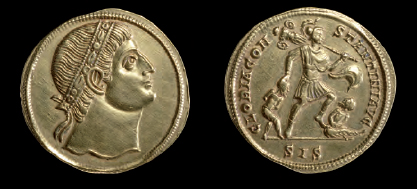
42. A four-and-a-half solidus gold multiple, minted at Siscia (modern Sisak, Croatia) in 326. On the obverse of the coin is a bust of the emperor gazing heavenwards. There is no inscription. On the reverse, the emperor, in military uniform, tramples or kicks a defeated foe with his left foot, and with his right hand drags a captive by the hair. Over his left shoulder, from which billows his paludamentum, he carries a tropaeum. (The Trustees of the British Museum)
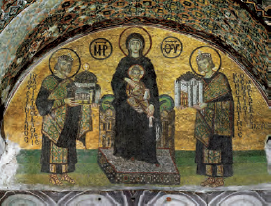
43. Mosaic of the Theotokos (Mother of God), above the eastern entrance to Hagia Sophia in Istanbul. She is shown receiving the Church of Holy Wisdom from Justinian and the city of Constantinople from Constantine. (akg-images/ Erich Lessing)
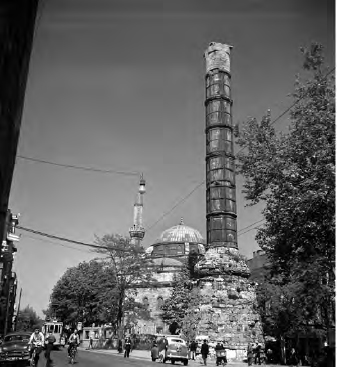
44. Porphyry column atop which once stood the statue of Constantine, now known as Çemberlitas, ‘the burnt column’, Istanbul. (Roger Viollet/TopFoto)

45. Rotunda of Galerius, Salonica (modern Thessaloniki), near the Arch of Galerius. (Author)
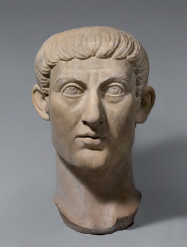
46. Bust of Constantine, sculpted after 325, now at the Metropolitan Museum of Art, New York. (Scala/Metropolitan Museum of Art/Art Resource)
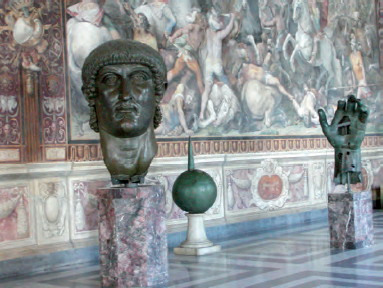
47. Bronze bust of Constantine, formerly believed to represent Constantius II, in the Capitoline Museums, Rome. (Author)
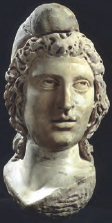
48. Head of Mithras, to be found in the Museum of London. (Museum of London/HIP/TopFoto)

49. Path lined with Roman sarcophagi, Alyscamps, Arles. (Author)

50. Red Sea sarcophagus, depicting Moses and the Israelites and the drowning of Pharaoh, in the Museum of Ancient Arles. (Author)

51. Carved relief panel from a second Red Sea sarcophagus, Museum of Ancient Arles. (Author)
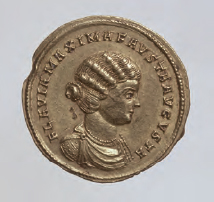
52. A gold coin struck for Fausta early in 326, now in the Münzkabinett, Staatliche Museen zu Berlin, Germany. The inscription reads FLAVIA MAXIMA FAUSTA AUGUSTA. (Scala/ BPK, Bildagentur fuer Kunst, Kultur and Geschichte, Berlin)
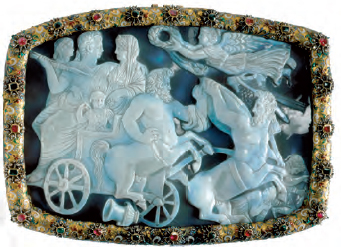
53. The Great Cameo, to be found in the Geld en Bankmuseum, Utrecht, which depicts Constantine and his family upon a chariot in a Dionysiac scene. The chariot is pulled by centaurs, and Victory hovers, crowning the emperor. (Utrecht Geldmuseum Collections)

54. The Belgrade Rider, a sardonyx cameo found in Serbia, which may depict Constantine. It is now in the National Museum, Belgrade. (Narodni Muzej, Belgrade/ Lauros/Giraudon/Bridgeman Art Library)
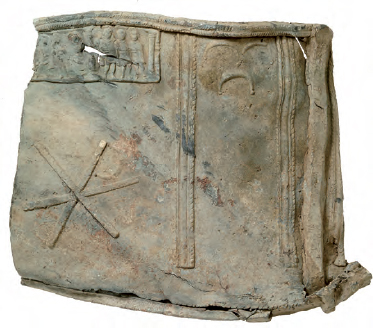
55. A portable lead baptismal font found at Walesby in Lincolnshire, showing catechumens preparing for baptism and a simple six-pointed star. (The Collection, Art and Archaeology in Lincolnshire)
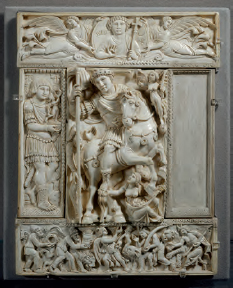
56. The victorious emperor defeating his enemies. Central section of the so-called Barberini Diptych, an ivory now generally dated to the sixth century, to be found in the Louvre, Paris. (Scala/Louvre)
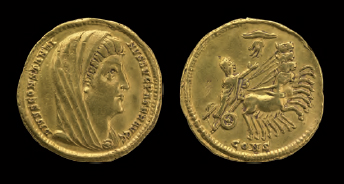
57. Consecratio coin struck to mark the death and apotheosis of Constantine. This example is to be found in the British Museum, London. (The Trustees of the British Museum)
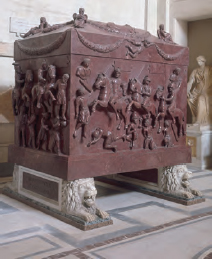
58. Helena’s sarcophagus. It was originally carved in porphyry for the body of Constantine, but remained in Rome, where it is now to be found in the Vatican Museums. (akg-images/Nimatallah)
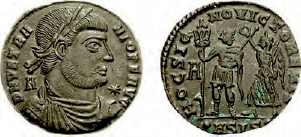
59. Coin of the usurper Vetranio, who challenged Constantine’s sons for the throne, with the legend HOC SIGNO VICTOR ERIS, ‘By this sign you shall become Victor’. (Classical Numismatic Group)

60. Silver largitio dish depicting Constantius II mounted beside a guardsman bearing a shield marked with the chi-rho. It is now in the Hermitage Museum, St Petersburg. (The State Hermitage Museum, St Petersburg)
When I come to Africa, I shall by reading a very plain verdict fully demonstrate to all … what sort of devotion should be paid to the greatest god and in what kind of cult he would appear to delight … Those who incite and do things so that the greatest god is not worshipped with the requisite devotion, I shall destroy and scatter. And as it is sufficiently apparent that no-one can obtain the blessings of martyrdom in a manner that is seen to be foreign and incompatible with religious truth, those whom I find to be opposed to right and religion itself, and apprehend in violation of the due form of worship, then these without doubt I shall cause to suffer the due penalties of their madness and their reckless obstinacy.
Fortunately for the Donatists, Constantine never embarked on this trip to Africa. However, he did follow Diocletian’s example and insist that all Christians worship in the fashion he had determined, on pain of death. And he went further than the Tetrarchs in arrogating to himself the right to determine what was, and what was not, martyrdom. The natural response to Constantine’s suppression of the Donatists, even as he pressed for toleration of all faiths, was the formulation and circulation of new tales of martyrdom. Between 317 and 321, according to these tales, imperial officers colluded with Caecilian’s followers to torture and execute the faithful. In the Sermon on the Passions of Saints Donatus and Advocatus, attributed to Donatus himself, imperial soldiers herded Donatists into a church in Carthage and slaughtered them all, hacking them to pieces that only later family members would reassemble. The tales may well be grisly and pious fictions, intended to fan the flame of dissidence in Donatist communities so that they might better resist the pressure to conform. But utter lies do not convince, and Constantine’s ire, which only subsided when his attention was drawn wholly to the east and to Licinius, suggests that his mandate of toleration did not extend to those he condemned as schismatics. The same intolerance would also be shown to those condemned as heretics – those who not only refused to acknowledge correct authority but also resisted correct belief.
The Arians and the Council of Nicaea
Even as the Donatist problem persisted, a second rift opened within the Christian Church of North Africa, beginning in Alexandria, a more important bishopric than Carthage and one which claimed apostolic foundation. A dispute had arisen between the bishop of Alexandria, Alexander, and one of his priests, Arius, who was a popular preacher. Arius earned the censure of his bishop for suggesting that God the Father preceded the Son and had created the Son from matter, which contradicted Alexander’s understanding of the relationship. This was in origin not an abstruse point of theology, however, as Alexander feared the challenge to his authority and to his right to determine correct belief for his flock. Many were turning to Arius, who found supporters particularly among other intellectuals. Arius’ greatest ally was a certain Eusebius – named surely to frustrate historians and those interested in clarity, for this was not Constantine’s biographer, by now bishop of Caesarea. This second Eusebius had been, with Arius, a pupil of Lucian of Antioch (murdered in the Great Persecution), and latterly was the bishop of Berytus (modern Beirut). In 318, against the rulings of several church councils (including Arles) which required bishops once appointed to shun promotion and remain in one place, Eusebius accepted a more senior posting and moved to Nicomedia in Bithynia. He is known to history, therefore, as Eusebius of Nicomedia.
Alexander of Alexandria convened, in around 319, a council of his subordinate priests (thirty-six) and deacons (forty-four), and announced its ruling in a letter despatched to leaders of other churches. ‘I wished indeed to consign this disorder to silence,’ he began, and had hoped that it would not spread to other regions ‘and contaminate the ears of the simple.’ But since ‘Eusebius, now in Nicomedia, thinks that the affairs of the Church are under his control because he deserted his charge at Berytus … and has sent commendatory letters everywhere’, Alexander issued a riposte, naming and shaming those he branded ‘apostates’ and ‘heretics’. The exact views that Arius and Eusebius shared have been obfuscated by the rhetoric of their detractors, who liked to reduce them to ‘sound bites’. Thus, Arius is most frequently said to have declared ‘There was when he was not’, referring to the existence of time and matter before the creation of the Son by the Father. The elegant apophthegm does not appear in the statement of faith in verse, the Thalia, that Arius produced, presumably to appeal to the ‘ears of the simple’. Numerous additional councils were convened and sides were taken before, perhaps disturbed by the unruliness of Christians under his jurisdiction, Licinius banned further convocations. This ruling was portrayed by Constantine’s propagandists as part of the tyrant’s renewed persecution, and so, upon achieving his victory at Chrysopolis, Constantine was obliged to turn rather quickly to the matter.
In 324 Constantine despatched Ossius of Cordoba to mediate between the parties at Antioch. He bore a letter that set out the emperor’s thoughts in all their simplicity. The letter has been preserved (VC II.64–72):
Victor Constantinus Maximus Augustus to Alexander and Arius
I call upon God himself to witness, as I should, the helper in my undertakings and Saviour of the Universe, that a two-fold purpose impelled me to undertake the duty which I have performed. My first concern was that the attitude towards the Divinity of all the provinces should be united in one consistent view, and my second that I might restore and heal the body of the republic which lay severely wounded. In making provision for these objects, I began to think out the former with the hidden eye of reason, and I tried to rectify the latter by the power of the military arm. I knew that if I were to establish a general concord among the servants of God in accordance with my prayers, the course of public affairs would also enjoy the change consonant with the pious desires of all.
Evidently, the emperor’s theology had not developed profoundly since the Council of Arles, and he proceeded to outline how the same concern had occupied him when dealing with the Donatists. This latest dispute was still more grievous, he opined, but ‘the cause was exposed as extremely trivial and quite unworthy of such controversy’. Those on both sides of the argument surely felt otherwise, since for them the nature of Christ affected the salvation of all for whom he died. To those opposed to Arius, he was a heretic who claimed that the Son was less than fully God, denied the divinity of his sacrifice, and hence barred the possibility of theosis, the deification of mankind. To Arius, those who maintained that the Father and the Son were equally eternal (coeternal) and of the same substance (consubstantial) were misleading their congregations into an earlier heresy, that of Sabellianism, which treated the Godhead as unitary and the Son and Holy Spirit as aspects of divinity. Salvation could only be guaranteed by correct belief, in Greek orthodoxia. Orthodoxy and the issue of salvation were not, to either party, trivial matters, and thus neither was likely to favour Constantine’s offer to act as ‘a peaceful arbitrator between you in your dispute’, even as he reiterated how ‘the matter is small and utterly trivial’, arising from a debate that should not have been aired. ‘It was neither right to ask about such things, nor to answer when asked.’
Constantine’s policy of least said, soonest mended was remarkably similar to Licinius’. But whereas the latter banned further discussion, Constantine assented to even more. When Ossius achieved no consensus in Alexandria, he moved on to preside at a council in Antioch, where the recent death of the bishop had led to a disputed election. A certain Eustathius had been installed, but Arians in the see had expressed their preference for another, the bishop of Caesarea whom we know as Eusebius, Constantine’s biographer. Ossius confirmed the selection of Eustathius, and the council provisionally excommunicated Eusebius of Caesarea and two other bishops. They were invited to attend a further council, to be held in Ancyra (modern Ankara), to confirm their acceptance of the majority view. This did not suit the emperor, however, who had witnessed the problems that arose when a council was left to its bishops to run. To guarantee a solution that would suit him, Constantine determined that all must once again come to him. He sent a letter summoning bishops not to Ancyra, but to Nicaea, ‘a city in Bithynia, both because the bishops from Italy [the bishop of Rome not among them] and the rest of the countries of Europe are coming, and because of the excellent temperature of the air, and in order that I may be present as a spectator and participant in those things that will be done’.
The only eyewitness account of the Council of Nicaea, which was only later called the first ecumenical council of the Church, was written by Eusebius of Caesarea around a decade afterwards. It was at the council that Eusebius met Constantine for the first time, and he was evidently impressed by the pomp and ceremony that surrounded the imperial person. That is to say, he elected to describe the emperor’s demeanour and majesty in handling the querulous bishops rather than the deliberations of the synod, which was quite correct given the nature of the work, the panegyrical Life of Constantine (VC III.4–24), and quite in keeping also with our interests. Nonetheless, his account became the basis for all later descriptions of the council, and consequently for the role Constantine played to be magnified. We can say little more than that Constantine gave a speech of welcome in Latin to the more than 250 bishops – later tradition holds there were 318, corresponding to the number of Abraham’s servants at Genesis 14 – mostly Greek-speakers, who attended at his expense, and that he acted on occasion as a mediator between controversialists, ‘and by speaking Greek, for he was not ignorant of that language either, he made himself pleasant and agreeable, persuading some and shaming others with his words’, urging unity at all times. Just as Constantius Chlorus was credited by panegyrists for recovering Britain in 296, although he failed to make it across the English Channel (see above, p. 94), so his son ‘presided’ over the Council of Nicaea. It seems certain, however, that Ossius of Cordoba played the role of Asclepiodotus, the unmentioned underling who took charge, in this case chairing sessions and controlling theological disputation. Constantine attended sessions and flattered many participants with his attentions, notably kissing the empty eye-sockets of one Paphnutius who had been blinded in the Great Persecution. However, it would later be charged that Constantine, or Ossius, shut down all intellectual exchange, imposing instead a solution based on the use of the term ‘consubstantial’ (homoousios). By using the very term that Arius rejected as the root of the heresy of Sabellianism, the fate of the preacher was sealed. He was condemned and exiled with two bishops who refused with him to agree to the statement of faith, which came to be known as the Nicene Creed. The method for determining the date for Easter, which all must observe, was also agreed, and Constantine undertook to enforce universal observance of orthodoxy, or ‘correct belief’.
The end of the council coincided, surely not by chance, with the end of Constantine’s vicennalia, and so the bishops were invited to the imperial palace in nearby Nicomedia – in 325 Constantinople was not yet complete – to dine and celebrate the emperor’s twentieth year in power. They were sent away with gifts and large cash donations for their churches. Besides praising his protagonist, Eusebius of Caesarea had further reasons to remain opaque on what took place at Nicaea, for his own role in the proceedings was hardly less controversial than that of his namesake, the bishop of Nicomedia. Constantine’s biographer had been named in letters that circulated prior to Nicaea as one sympathetic to the teachings of Arius, and had been excommunicated provisionally by the Council of Antioch. At Nicaea he advanced his own statement of faith, setting out how he understood the Trinity. His was not the same creed as that adopted by the council: notably it omitted the term ‘consubstantial’. However, he agreed to the Nicene version and returned to his see in full communion. Eusebius of Nicomedia also signed the creed, but did not agree to the exile of Arius. Shortly afterwards, he was charged with corresponding with Arius and also exiled by order of the emperor. This was a striking turn of events, for Nicomedia was still Constantine’s imperial capital.
To explain his actions, Constantine sent a letter to the Christians in the city denouncing their deposed leader. Eusebius of Nicomedia, Constantine charged, had supported the ‘tyrant’ Licinius. The accusation must be understood in the context of Constantine’s programme to condemn the memory of Licinius, as he had Maxentius before and Maximian still earlier, but also as an attempt to obscure the favour the emperor had previously shown the bishop. It is likely that the council had been moved to Nicaea at Eusebius’ request, and that as metropolitan bishop in Bithynia, in which Nicaea was situated, he was allowed to address the council before any but Constantine. So we read in the letter that, as battle loomed at Chrysopolis in 324, Constantine had arrested as spies the priests and deacons who had accompanied Eusebius to the scene of battle. It is hardly surprising that the bishop and his entourage had made contact with the emperor and his invading army at Chrysopolis, which fell within Eusebius’ jurisdiction on the Asian side of the Bosphorus. Moreover, the suggestion that they were agents of Licinius seems to contradict the notion that Licinius had turned to persecuting Christians, unless Constantine is now suggesting rather ludicrously that his rival made exceptions. In short, we have another example of Constantine’s predilection to shape the past to suit present circumstances. In the immediate aftermath of Nicaea, Arians were out of luck and ‘Catholics’, adherents of the universal and orthodox Church, were in favour. Consequently, the former were portrayed as colluders with a persecuting tyrant. The congregation at Nicomedia was to ‘act so that we may rejoice in the possession of holy, orthodox and philanthropic bishops. And if anyone dares inconsiderately to be roused to remembrance or praise of those corrupters, he will be restrained from his daring by the action of the servant of God, namely myself. God guard you, beloved brethren.’
The Christian emperor after Nicaea
Little, then, had been changed in Constantine’s attitude by his failure to suppress the Donatists by force, and once again he saw the threat of violence as a solution to the recalcitrance of fellow Christians, his ‘beloved brethren’, who had so recently enjoyed similar treatment from Diocletian, at whose court in Nicomedia Constantine had resided during that very period. Here we might recall Constantine’s own Oration to the Saints, a speech to assembled bishops, delivered most likely in Nicomedia. It has been suggested that the oration was given as early as 315, but a later date seems more likely, and one might dwell on the claims to Christian leadership Constantine advances therein. A key element of the speech was to convince the bishops in his own words, and not only in those of Lactantius and Ossius, that he was not responsible for persecutions of Christians. To that end, Constantine emphasized that he was not raised a Christian and had come to his faith through grace. Eusebius of Caesarea embraced that message and disseminated it, crediting Constantine with converting his mother Helena, for to suggest that she had raised her son to venerate the Christian god would open him to charges of apostasy and inconstancy. Indeed, one might begin to see in his virulent attacks on the Donatists an attempt to protect himself from the charges they levelled at less rigorous Christians who had not embraced martyrdom during the persecution, and similar self-serving tactics in his threats to the various groups of heretics. It is especially noteworthy that the emperor felt entitled to threaten the Christians of Nicomedia, who would have observed Constantine at Diocletian’s palace listening to the lectures by Porphyry and Sossianus Hierocles, and would perhaps have seen his acquiescence when the first of their community, and Lucian of Antioch, were executed. To cover his tracks, Constantine now ordered that all copies of Porphyry’s Against the Christians be burnt and that the same fate be afforded anyone found in possession of a copy.
For good measure, Constantine issued a threatening letter addressed to every other group of heretics and schismatics known to him. It has been preserved by Eusebius (VC III. 63–6):
Be it known to you by this present decree, you Novatians, Valentinians, Marcionites, Paulians and those called Cataphrygians, all in short who constitute the heresies by your private assemblies, how many are the falsehoods in which your idle folly is entangled and how venomous the poisons with which your teaching is involved, so that the healthy are brought to sickness and the living to everlasting death through you … Accordingly, since it is no longer possible to tolerate the pernicious effect of your destructiveness, by this decree we publicly command that none of you henceforth shall dare to assemble. Therefore, we have also given order that all your buildings are to be confiscated, the purport of this extending so far as to prohibit the gathering of assemblies of your superstitious folly not only in public but also in the houses of individuals or other private places … let [these places] be confiscated and handed over incontestably and without delay to the Catholic church, and let other sites become public property.
The date of this decree has been much debated, since Eusebius places it after the Council of Nicaea, although at that council the Novatianists were shown some sympathy. A date after Nicaea seems very likely, as Constantine no longer regards alternative doctrines as ‘trivial’, but rather stresses that those led astray by heretic priests surrender salvation and face ‘everlasting death’. So it may be that Eusebius displays his own prejudice against the Novatianists by inserting them at the start of the list of those condemned to lose their property. Constantine’s policy is evidently an extension of his failed suppression of the Donatists, the object now being to dispossess all those whose doctrines or leaders were not currently recognized as ‘Catholic’. The emperor had taken the lead in enforcing correct worship in a manner Diocletian and Galerius would have recognized, and by his actions one group of Christians benefited materially.
Constantine’s professed policy of toleration for all faiths, for which he had fought his last great war against Licinius, foundered on the diversity of Christian doctrine and practice. In the name of unity he persecuted those whose beliefs were now far closer to his own than those held by worshippers of Sol Invictus, and still more than those of devotees of Dionysus or Asclepius. Whereas those who had not yet found the Christian god should be led in that direction by moderation, those who had done so but rejected correct authority (schismatics) or correct belief (heretics) were to be pressured equally, and punished if they failed to relent. The diminished status of schismatics and heretics was confirmed in laws issued in 326 (CTh 16.4.5; 16.5.1), and it is in the Theodosian Code that we observe how this was subsequently reinforced through the following century. Numerous chapters are devoted to heretics and schismatics, where punishments are far harsher than those meted out to pagans, who were as yet children and not threats to the unity of the true faith. During Constantine’s reign, heretics and schismatics were not to share in the bounty that accrued to the true ‘Catholic’ faith, until the emperor changed his mind. Constantine changed his mind frequently.
In 327 Constantine, the champion of orthodoxy and benefactor of the Catholic Church, had no compunction about repealing the exile of Arius, and shortly afterwards of Eusebius of Nicomedia. In a letter of eloquence and guile that struck just the right note with Constantine, Arius promised to pray for the emperor and his family from the bosom of the peaceful and unified Church. Eusebius’ letter was rather more procedural, observing the oddity that he would still be exiled when the man with whom he had corresponded was not. Both matters were put before another great council, recorded rather briefly in the Life of Constantine (VC III.23). Attended once again by more than 250 bishops, the council held in Nicomedia in December 327 was hardly noted by later historians such as Socrates Scholasticus and Sozomen. A notable exception is Philostorgius (II.7), who records that the Arians also circulated a revised creed at this meeting. The council reversed the decisions of Nicaea: Eusebius of Nicomedia was recalled and lost no time in returning to his church and fomenting trouble for his opponents; Alexander of Alexandria was ordered to receive Arius back into his see, but refused. Alexander died shortly afterwards, in April 328, which proved to be to the detriment of the Arians, as it brought to the fore a young and brilliant new bishop of Alexandria named Athanasius.
The emperor’s actions in the years after Nicaea were inconsistent, although his purpose was consistent: he remained committed to the unity of faith and worship of the greatest god, but lacked a clear idea of how to achieve it. No longer was there a dominant voice at court, for by the end of 326 Ossius of Cordoba had departed for Spain. Constantine’s Christian adviser for more than a dozen years, he was recognized at Nicaea as ‘the most famous one’, and remained an implacable opponent of Arianism in his diocese. Why Ossius left is a mystery, but perhaps not a great one: he may simply have wished to leave the limelight and serve his parishioners. However, his willingness to cast aside such influence at this crucial juncture lends itself to further conjecture, and perhaps one might link Ossius’ departure to the murders of Crispus and Fausta. Was the bishop unable to prevent the episodes, unable to offer Constantine the forgiveness he sought, or perhaps both? We might recall from an earlier chapter that Zosimus, a pagan author of the sixth century, referred in his tale of Constantine’s conversion to ‘a certain Egyptian, who had come from Spain to Rome’, who is portrayed as the emperor’s means to secure absolution for the murders. Without Ossius’ guidance, Constantine floundered from council to council, accepting and rejecting suggestions from those who wished him to coerce opponents. For some time, and rather shockingly for the Catholics, the emperor fell under the spell of a man he had previously condemned but who now was once again his local bishop, Eusebius of Nicomedia.
The politicking and chicanery of the following years cannot be explored in detail here, since our interest is not ecclesiastical politics. Instead we shall consider what Constantine’s actions and rulings tell us, if anything, of his mind and demeanour in his last decade. In 328 Athanasius was ordered, like Alexander before him, to accept the ruling of the Council of Nicomedia and restore Arius and his followers to full communion with the Alexandrian church. He resisted this order from his base in Egypt, frequently fleeing Alexandria into the Upper Thebaid, that is the desert, to live among the monks and avoid the officers sent to enforce the emperor’s will. Athanasius even challenged the emperor’s monopoly of legitimate violence, sacking rival churches, upending altars and destroying liturgical vessels, or so it was charged by his bitter rivals. In 332, facing such serious accusations, Athanasius was obliged finally to present himself to the emperor and defend the charges, at a trial engineered by Eusebius of Nicomedia. Evidently, the latter’s influence had waned since Constantine’s move to Constantinople, for Athanasius was acquitted. He returned victoriously to Alexandria and turned shortly afterwards to Libya, where Arius and his community were living, to assert his authority over suffragan bishoprics and to ensure the rejection of Arian candidates. Arius responded angrily in a letter to Constantine, and that was his undoing.
Constantine, although he now devoted more of his energy to the Christian Church, remained a military man, who took counsel from his subordinates but made the decisions himself and gave orders that none were permitted to countermand. Military discipline was predicated on recognition of the commander’s absolute authority, which was reinforced by codified acts of violence. Ultimately, acts of insubordination, if sufficiently egregious, were punishable by death. A similar code of conduct did not apply in Constantine’s dealings with the bishops, although on many occasions he assumed that it did. When persuasion and flattery failed to achieve the emperor’s desired end, he might try again. When frequent attempts failed, he would resort to threats and to acts of violence. This was the case with the Donatists and with other groups of schismatics, and it was his last resort with Arius. In 332 Arius wrote to insist that the emperor move against Athanasius to ensure that he, Arius, and his many followers were readmitted to the Alexandrian church. One did not insist when dealing with the emperor, still less threaten, as did Arius, to establish his own separate church. Two letters were despatched from Constantine: the first, to Arius personally, called him the mouthpiece of Satan and much else besides; the second informed everyone else of Arius’ fate and that of his writings:
Since Arius has imitated wicked and impious people, it is just that he should undergo similar ignominy. Therefore, just as Porphyry, that enemy of piety, for having composed licentious treatises against religion, found suitable compensation when he was branded with infamy, overwhelmed with reproach, and his blasphemous writings were destroyed; so it shall be with Arius, and those who share his sentiments shall be called Porphyrians, that they may hold the appellation of those whose conduct they have imitated. And in addition to this, let any treatise composed by Arius be consumed by flames, so that not only will his depraved doctrine be suppressed, but also so that no memorial of any kind will be left for him.
Those concealing books by Arius, like Porphyry before him, were to be executed if they did not immediately burn them. Priests who refused to submit to the authority of a Catholic bishop were to pay additional taxes and were no longer exempt from state liturgies; that is, they must pay for local amenities and services in the manner of other notables. Arius was to present himself to the emperor for final judgement. His fate was sealed, it seemed. And yet on the next occasion that we meet Arius, in 335, he is on his way to the Holy Places, where a council of bishops is convening at Tyre to judge Athanasius. Once again charged with egregious offences, the bishop of Alexandria had already demonstrated that he was innocent of the murder of one Arsenius, countering the production of a severed limb by his accusers with the intact, and living, body of his alleged victim. But again, in 335, Eusebius of Nicomedia constructed an alliance of those opposed to Athanasius, who brought charges of violence and contumacy against him, and once again the emperor responded by summoning a council under the usual conditions: all expenses were to be paid, and all were obliged to attend.
Constantine tasked the Council of Tyre with a rather familiar duty, to restore unity to the Church. This was now a rather feeble refrain, and the bishops conducted their own business, blithely ignored by Eusebius of Caesarea (VC IV. 41-2), who presents the affair simply as a prelude to the emperor’s tricennalia celebrations and the dedication of the Church of the Holy Sepulchre in Jerusalem, where he delivered his oration in praise of the building and its patron. Shortly thereafter, Eusebius travelled to Constantinople with Eusebius of Nicomedia and others to ensure that the decision of the council was enforced and that Athanasius was sent into exile. Athanasius beat them to court, but after yet another audience with the emperor and yet another change of heart, Constantine first sided with Athanasius, then sent him into exile at Trier. But when Arius returned to Alexandria, those loyal to Athanasius refused to accept him. He returned, once again, to Constantinople and to another council under Constantine’s gaze. There it was determined that Arius would be brought into full communion by the bishop of Constantinople, who then refused, revealing himself to be a supporter of Athanasius. Under imperial instruction, Arius was to be marched into church and admitted into full communion, but he never made it. Tradition holds that he died on the way, a hideous death reminiscent of Galerius’, which in Lactantius’ account drew heavily upon the death of Antiochus, persecutor of the Jews in 2 Maccabees. Arius’ demise demonstrated that God’s judgement on the matter of His own nature and substance ultimately differed from Constantine’s.
The Church after Constantine
As Constantine had reminded his bishops after Arles, ‘the judgement of the priests should be regarded as if God himself were in the judge’s seat’, but when it was not, then he, Constantine, took that seat. The final right of appeal was to him alone, for the Holy Spirit had entered him as it did a bishop at ordination, and worked through him as it did a bishop when he administered the sacraments. And if Constantine’s right to preside over all Christians had been established at Arles, his ability to do so was shown at Nicaea. His knowledge of the Christian faith developed as he attended councils and his legislation was formulated through decades in consultation with bishops; and bishops now turned to him as a matter of course as the final arbiter in their disputes and as the enforcer of their decisions. Consequently, for a decade after Nicaea, if we follow our principal sources, Constantine appears to have devoted extraordinary time and energy to the Christian Church and its bitter disputes. And in those disputes he appears to have followed no consistent line, veering between sides rather suddenly and without adequate explanation. His ostentatious displays of tolerance, calling council after council, were punctuated by violent outbursts and threats of persecution, all in the name of a unity that he never achieved.
We must be wary of this picture for two reasons. First, Constantine is presented to us primarily by Eusebius of Caesarea, who was deeply enmeshed in the affairs he describes, and by various Christians at the time and later – Catholics, Arians, Donatists and others. Constantine’s views, expressed in his letters, are not presented except where they can be shown to conform to one viewpoint or another. Second, and more significantly, all sides in the discussions were interested in the emperor only insofar as he played a role in their own lives and disputes. Eusebius is perfectly open in this regard: he tells us (VC I.11) that he will not devote space to wars or peacetime decrees – although of course he frequently does – but ‘will put into words and write down only what relates to the life which is dear to God’. That is, he is concerned exclusively with Constantine’s relationship with the Christian Church. So it is also with Eusebius’ Ecclesiastical History, and the continuations of that work by others, including Socrates Scholasticus and Sozomen. It may be, therefore, that Constantine devoted rather little time and energy to the affairs of the Church over the last decade of his life, albeit relatively far more than at any other period. So much would appear to be the case if we relied only on the Origo Constantini, or perhaps also on Zosimus and Eunapius, which are far shorter accounts and not by eyewitnesses. We have only terse comments on, for example, the emperor’s close relationship with the Neoplatonist philosopher Sopater, formerly a courtier of Licinius, but would love to know more about his patronage of the literary arts and oratory. If we had an account of the emperor’s last years penned by one of Constantinople’s new senators, one suspects he would have been a sedulous attendee of debates and the greatest patron of municipalities and their public works.
For all the hyperbole of our skewed sources, it is clear that Constantine’s interventions had a profound effect upon the Church. It was not in spite of Constantine’s conversion and patronage of the Church that disputes became more frequent and more pronounced, but rather because of them. Indeed, it is because of Constantine’s actions that we have begun to speak of the Church, still rather incongruously. For that reason it may be useful to take a step backwards and indulge very briefly in some jargon-laden theorizing. Sociologists of religion would consider Christianity after Constantine’s reign to be a cult in a state of ‘reduced tension’ with state and society. It was, therefore, a breeding ground for the formation of splinter groups or sects. One can distinguish between cults and sects rather simplistically: a cult is characterized by the willingness of its members to embrace new ideas, whereas a sect is distinguished by its members’ resistance to new ideas. Cults tend to attract those who are not strongly attached to another faith and who are generally better educated and wealthier. Sects fragment from established cults and tend to consist of those who have benefited least in material terms from association with the cult, and for whom increased secularization (contact with ‘the world’) seems to diminish the spiritual elements of the faith. In other words – and they are surely necessary – the more worldly the Christian Church became, the more likely it was that sects would develop that rejected worldliness and turned away.
Christianity, as we have seen, was a cult that had been arranged rather loosely across a vast region for three centuries. It was based on open networks that after a long period of being closed off from secular power structures were now increasingly folded into them. The cult had endured frequent fragmentation through its first three centuries, when sects turned away from it and its looser connections to state and society. This became much more frequent as the Christian cult became favoured by the emperor and attained its most tainted state. And yet, as we have seen, many of those sects made appeals (at least initially) to the emperor, to the worldly centre, for judgement, even if they rejected that judgement when it went against them. Centripetal forces were stronger than centrifugal ones, and this bolstered the status of bishops, who were the link between centre and periphery. Having been, to a great extent, distinct from each other, diverse communities of the faithful were now bound together through imperial legislation and patronage, and by councils attended by their bishops.
The view that the Church was corrupted by its encounter with Constantine, replacing martyrs and pacifists with patriarchs and militants, was thus forged in his own era, and it has retained its vigour into the modern period. Many have argued that the Church became an instrument of the state and that the original message of Christianity was lost. Bishops were at the forefront of this deterioration, no longer spiritual leaders but instead provincial factotums, representatives of a new state-centred ecclesiastical structure with duties and interests that intersected with the civilian and military administrations. Although bishops were never brought fully into the imperial administration and continued to derive their status from recognition of their spiritual authority as demonstrated by ascetic behaviour, still they were increasingly required to write letters of petition, or to travel to the residence of a provincial governor or even to the imperial court to petition in person. So frequently indeed did bishops afford themselves of this opportunity to travel, that restrictions were introduced at two church councils in the 340s. With a duty to advocate, bishops were now mostly among the best educated and best connected people in each community – if not always born into wealth, then certainly able to attain it with high social standing. They were afforded titles as splendid as those attached to senators, ‘the most glorious’ (gloriosissimus) or illustrious (illustris). Indeed, bishops were drawn increasingly from the senatorial aristocracy. An apt phrase developed to describe these patrician bishop advocates: ‘noble by birth, still nobler through religion’.
Constantine’s reign was, therefore, a watershed for episcopal authority, even if it did not utterly change the nature of the office. The same can be said for its impact on the Church’s stance on war and violence. As we have seen, there were many Christian attitudes to war and violence, and pacifism was certainly strongly represented among them. This remained the case after Constantine. But as a consequence of his conversion and the consistent message disseminated from his court that the ‘greatest god’ was his patron, Constantine established Christianity as the religion of victory within the army. The remarkable efforts of certain apologists, notably Lactantius and Eusebius, enabled those who had already converted to share the Good News: Christianity was on the march.